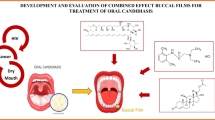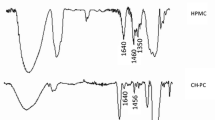Abstract
Buccal bioadhesive films, releasing topical drugs in the oral cavity at a slow and predetermined rate, provide distinct advantages over traditional dosage forms. The aim of present study was to prepare and evaluate buccal bioadhesive films of clotrimazole for oral candidiasis. The film was designed to release the drug at a concentration above the minimum inhibitory concentration for a prolonged period of time so as to reduce the frequency of administration of the available conventional dosage forms. The different proportions of sodium carboxymethylcellulose and carbopol 974P (CP 974P) were used for the preparation of films. Carbopol was used to incorporate the desired bioadhesiveness in the films. The films were prepared by solvent casting method and evaluated for bioadhesion, in vitro drug release and effectiveness against Candida albicans. In vitro drug release from the film was determined using a modified Franz diffusion cell while bioadhesiveness was evaluated with a modified two-arm balance using rabbit intestinal mucosa as a model tissue. Films containing 5% CP 974P of the total polymer were found to be the best with moderate swelling along with favorable bioadhesion force, residence time and in vitro drug release. The microbiological studies revealed that drug released from the film could inhibit the growth of C. albicans for 6 h. The drug release mechanism was found to follow non-Fickian diffusion.

Similar content being viewed by others
References
A. N. Ellepola, and L. P. Samaranayake. Antimycotic agents in oral candidiasis: an overview:1. Clinical variants. Dent. Update. 27:111–116 (2000).
H. A. Albougy and S. Naidoo. A systematic review of the management of oral candidiasis associated with HIV/AIDS. SADJ. 57:457–466 (2002).
E. D. Pienaar, T. Young, and H. Holmes. Interventions for the prevention and management of oropharyngeal candidiasis associated with HIV infection in adults and children. Cochrane Database Syst. Rev. 3:CD003940 (2006).
E. Anaissie. Opportunistic mycoses in the immunocompromised host: experience at a cancer center and review. Clin. Infect. Dis. 14(suppl 1):S43–S53 (1992).
J. V. Roey, M. Haxaire, M. Kamya, I. Lwanga, and E. Katabira. Comparative efficacy of topical therapy with a slow release mucoadhesive buccal tablet containing miconazole nitrate versus systemic therapy with ketoconazole in HIV-positive patients with oropharyngeal candidiasis. J. Acquir. Immune Defic. Syndr. 35:144–150 (2004).
M. V. Martin. Antifungal agents. In L. P. Samaranayake, and T. W. MacFarlane (eds.), Oral Candidiasis, Butterworth and Co, London, 1990, pp. 238–259.
M. Plempel, K. Bartmann, K. H. Buchel, and E. Regel. BAY b 5097, a new orally applicable antifungal substance with broad-spectrum activity. Antimicrob. Agents Chemother. 69:271–274 (1969).
S. Bouckaert, and J. P. Remon. In-vitro bioadhesion of a buccal, miconazole slow release tablet. J. Pharm. Pharmacol. 45:504–507 (1993).
T. Save and P. Venkitachalam. Buccoadhesive tablets of nifedipine in standardization of a novel buccoadhesive erodible carrier. Drug Dev. Ind. Pharm. 20:3005–3014 (1994).
A. Ahuja, R. K. Khar, and J. Ali. Mucoadhesive drug delivery systems. Drug Dev. Ind. Pharm. 23:489–515 (1997).
N. A. Nafee, F. A. Ismail, N. A. Boraie, and L. M. Mortada. Mucoadhesive buccal patches of miconazole nitrate: in vitro/in vivo performance and effect of ageing. Int. J. Pharm. 1–2:1–14 (2003).
V. Agarwal, and B. Mishra. Development and biopharmaceutical properties of buccoadhesive compacts of pentazocine. Drug Dev. Ind. Pharm. 25:701–709 (1999).
J. L. Kanig, and H. Goodman. Evaluative procedures for film forming materials used in pharmaceutical applications. J. Pharm. Sci. 51:77–83 (1962).
K. K. Peh, and C. F. Wong. Polymeric films as vehicle for buccal delivery: swelling, mechanical, and bioadhesive properties. J. Pharm. Pharmaceut. Sci. 2:53–61 (1999).
B. Parodi, E. Russo, G. Caviglioli, S. Cafaggi, and G. Bignardi. Development and characterization of a buccoadhesive dosage form of oxycodone hydrochloride. Drug Dev. Ind. Pharm. 22:445–450 (1996).
F. Nakamura, R. Ohta, Y. Machida, and T. Nagai. In-vitro and in vivo mucoadhesion of some water soluble polymers. Int. J. Pharm. 134:173–181 (1996).
R. Khanna, S. P. Agarwal, and A. Ahuja. Mucoadhesive buccal tablets of clotrimazole for oral candidiasis. Drug Dev. Ind. Pharm. 23:831–837 (1997).
F. A. Mohammed, and H. Khedr. Preparation and in vitro/in vivo evaluation of the buccal bioadhesive properties of slow-release tablets containing miconazole. Drug Dev. Ind. Pharm. 29:321–337 (2003).
R. J. Holt. Laboratory tests of antifungal drugs. J. Clin. Path. 28:767–774 (1975).
J. Varshosaz, and Z. Dehghan. Development and characterization of buccoadhesive nifedipine tablets. Eur. J. Pharm. Biopharm. 54:135–141 (2002).
H. S. Cheng, H. Park, P. Kelly, and J. R. Robinson. Bioadhesive polymer as platforms for oral controlled drug delivery II: synthesis and evaluation of some swelling water-insoluble bioadhesive polymers. J. Pharm. Sci. 74:399–405 (1985).
P. B. Deasy and C. T. O’Neill. Bioadhesive dosage form for peroral administration of timolol base. Pharm. Acta Helv. 64:231–235 (1989).
R. W. Krosmeyer, R. Gurny, E. Doelkar, P. Buri, and N. A. Peppas. Mechanisms of solute release from porous hydrophilic polymers. Int. J. Pharm. 15:25–35 (1987).
L. Shargel, and B. C. Andrew. Applied biopharmaceutics and pharmacokinetics, Prentice Hall, Appleton-Century-Crofts, New York, 1992.
P. L. Ritger and N. A. Peppas. A simple equation for description of solute release II. Fickian and anomalous release from swellable devices. J. Control. Release. 5:23–36 (1987).
N. A. Peppas, and R. W. Krosmeyer. Hydrogels in medicine and pharmacy: properties and applications, CRC, Boca Raton, (1986), p. 109.
Author information
Authors and Affiliations
Corresponding author
Rights and permissions
About this article
Cite this article
Singh, S., Jain, S., Muthu, M.S. et al. Preparation and Evaluation of Buccal Bioadhesive Films Containing Clotrimazole. AAPS PharmSciTech 9, 660–667 (2008). https://doi.org/10.1208/s12249-008-9083-3
Received:
Accepted:
Published:
Issue Date:
DOI: https://doi.org/10.1208/s12249-008-9083-3




